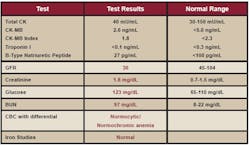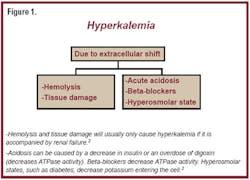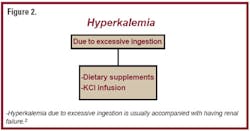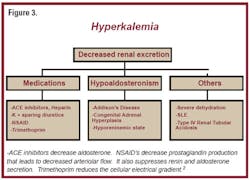A
morbidly obese 63-year-old, diabetic Caucasian woman was brought to the
emergency room on May 17, 2007, after falling and hitting her head while
taking a shower. At the time of the fall, she noted muscle weakness,
heartburn, and a blood sugar of 80 with no loss of consciousness. She
said she had no apparent signs or symptoms for the past few days. (For
her past medical history, physical exam, and surgeries, see Table 1.)
The patient had no history of using illicit drugs
or alcohol. She had been placed on a strict diet recently which included
lots of fruit (apples, pears, and bananas) and vegetables (lettuce and
tomatoes). She was, however, on 13 outpatient medications: Lantus,
Singulair, aspirin, Niferex, Toprol, Lasix, Zestril, Lipitor,
propoxyphene, Aldactone, Plavix, Prilosec, and Cardizem, as well as home
oxygen. She cited allergies to codeine, Celebrex, sulfa, Vioxx, and
penicillin. Upon admission as an inpatient, she was prescribed an
additional 15 medications.
The patient's laboratory results are shown in Tables
2 and 3. The physician ordered a basic metabolic panel for six days, cardiac
labs, and a complete blood count with differential on admittance. The
results from the basic metabolic panel showed a decreased sodium, an
increased potassium, and a decreased CO2 on admittance. A decreased GFR, an
increased glucose, creatinine, and BUN also were seen on admittance. The
remaining tests showed normal cardiac labs and a normocytic/normochromic
anemia. The sodium and potassium levels were repeated by a direct
potentiometric method. Questions to consider were 1) what was the cause of
this woman's fall and muscle weakness; 2) what conditions in her past could
have lead to this present condition; and 3) what laboratory results
presented support the diagnosis of this condition?
Results
Importance of potassium in the body
Potassium is important for cell maintenance,
cellular-membrane potential, and homeostasis of cell volume.1
Potassium is eliminated from the body through the gastrointestinal tract and
kidneys. Renal elimination is passive through the glomeruli of the kidney,
while there is active reabsorption of potassium, along with sodium and
chloride, in the proximal tubule and ascending limb. There is excretion of
potassium in the distal tubule and collecting duct, which is controlled by
aldosterone.2 Other factors that regulate distal
tubular secretion of potassium include intake of sodium and potassium, water
flow rate in the distal tubule, and acid-base balance.3
There are two mechanisms for potassium regulation in
the human body. One course is that ingested potassium enters the
circulation, stimulating the pancreas to release insulin. Elevated insulin
levels cause transport of potassium into cells via Na+/K+ ATPase. This pump,
by active transport, moves three sodium ions out of the cell for every two
potassium ions that move into the cell. If increased potassium is present in
the circulation, another route involves the kidneys releasing renin. This
stimulates hepatic activation of angiotensin I that is converted to
angiotensin II in the lungs. Angiotensin II stimulates the adrenal gland to
secrete aldosterone, which causes renal cortical collecting ducts to excrete
potassium and retain sodium.4
Pathophysiology
Serum/plasma potassium levels are only an approximate
indicator of total body potassium. Hyperkalemia is a concentration of serum
potassium above the reference limit of 5.0 mmol/L. This can be caused by
redistribution (shift of potassium out of the cells), increased potassium
intake, or increased retention (reduced renal potassium excretion). Figures
1, 2, and 3 outline each cause of hyperkalemia. Hyperkalemia can be a
life-threatening condition, and its diagnosis should be made from a clinical
history, review of medications, and a physical exam. Most of these
conditions are seen in premature babies and the elderly.3 Three
mechanisms causing the condition of hyperkalemia are reduced aldosterone and
response, renal failure, and reduced distal delivery of sodium.2
This patient had chronic renal failure, was taking
prescription drugs (Zestril is an ACE inhibitor, Toprol is a beta-blocker,
and Aldactone inhibits aldosterone), ate a large volume of food that
contained potassium (bananas), and had diabetes. All these conditions
contributed to her hyperkalemia. Her increased serum potassium level on
admittance supports her diagnosis of hyperkalemia. Her creatinine, GFR, and
BUN results support her condition of renal failure.
When a patient has hyperkalemia, the signs and
symptoms that are usually present include fatigue, weakness, tingling,
numbness, paralysis, palpitations, difficultly breathing, and mental
confusion.5
Cardiac effects can be seen due to bradycardia and on the ECG there will be
a prolonged PR and QRS intervals with peaked T waves.3 The
patient in this case had fatigue and muscle weakness but did not undergo an
ECG.
Pre-analytical causes
Prior to running a specimen for a potassium level,
there are causes that can create a factitious or pseudohyperkalemia reading,
it is important to recognize these factors. These include leukocytosis
(>50,000/mm3), thrombocytosis (>10^6/mm3), and erythrocyte (RBC) hemolysis
(Note: The samples in this case were not hemolyzed.) When these cells break
down, they release potassium into the circulation, thus increasing the serum
potassium level (make sure rhabdomyolysis is not the underlying cause).
Pre-analytical causes can also be due to improper collection (e.g.,
excessive fist clenching, incorrect order of draw [K+ EDTA may be back
flushed into the serum separator tube] and collecting above an IV line of a
potassium infusion). Sample processing errors may include centrifuging (more
than once) and refrigeration.6,7
Treatment
In this case, the patient was treated with dextrose,
insulin, and Kayexalate. The dextrose and insulin temporarily shift
potassium back into the cells, and the Kayexalate exchanges sodium for
potassium and binds it in the large intestine. Other options for treatment
include calcium supplementation (decreases myocardial excitability),
bicarbonate therapy (stimulates Na+/K+ ATPase), Salbutamol (B2-selective
catecholamine which promotes K+ into cells), dialysis, diuretic, diet low in
potassium, and discontinuation of certain medications.5
Summary and case resolution
Hyperkalemia is a serum potassium concentration
greater than 5.0 mmol/L. The following causes contributed to this patient's
hyperkalemia: chronic renal failure, prescription drugs (Zestril, Toprol,
and Aldactone), increased potassium in food, and diabetes. Zestril is an ACE
inhibitor that decreases aldosterone synthesis. Toprol is a beta-blocker
that decreases Na+/K+ ATPase activity. Aldactone inhibits binding of
aldosterone to receptors in the renal tubule.
She had been placed on a strict diet recently which included a lot of
fruit (apples, pears, and bananas) and vegetables (lettuce and
tomatoes).
Pre-analytical causes include factitious (pseudohyperkalemia),
collection errors, or sample processing errors. Hyperkalemia can be
physiologically caused by redistribution, increased potassium intake, or
increased retention. This condition is usually treated with
dextrose/insulin, Kayexalate, calcium, bicarbonate, diuretic, low potassium
diet, dialysis, or discontinuation of medication.
Michael Lazzari, MS, BS(CLS), MT(ASCP),
recently completed his master's in Clinical Laboratory Management at
Michigan Technological University in Houghton, MI, and is currently working
as a medical technologist at War Memorial Hospital in Sault Ste. Marie, MI.
He will be starting his doctoral studies in June 2009.
References
- Magee CC. Hyperkalemia. MedLine Plus. December 2005. ADAM. February 19,
2007.
www.nlm.nih.gov/medlineplus/ency/article/001179.htm . Accessed
January 15, 2007. - McPherson RA, Pincus MR. Henry's Clinical Diagnosis and Management by
Laboratory Methods. 21st. Philadelphia: Saunders, 2006. - 3. Burtis CA,.Ashwood ER, Bruns DE. Tietz Fundamentals of Clinical
Chemistry. 5th ed. Philadelphia: Saunders, 2001. - Hollander-Rodriguez JC, Calvert JF, Jr. Hyperkalemia.
Am Fam Physician. 2006;73:283-290.
http://www.aafp.org/afp/20060115283.html. Accessed January 15, 2007. - Lederer E. Hyperkalemia. eMedicine-Hyperkalemia. April 19, 2006.
February 19, 2007.http://www.emedicine.com/med/topic1082.htm
. Accessed on January 16, 2007. - Sykes E. “Causes of Increased Serum Potassium.” Presented at William
Beaumont Hospital on April 4, 2001. - Baer DM, Ernst DJ, Willeford SI, Gambino R. Investigating elevated
potassium values. Medical Laboratory Observer. 2006(11);38:24-31.







